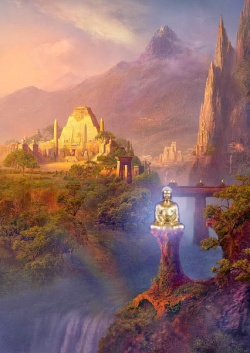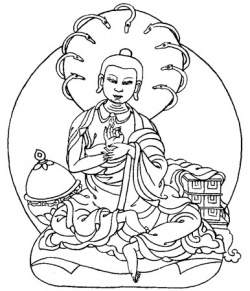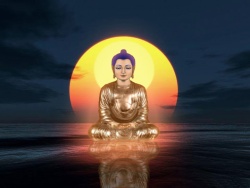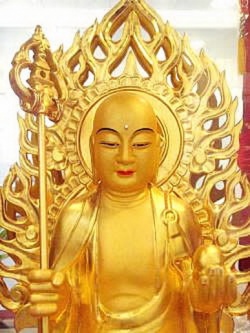Amida ji
Amida ji
One of the most common names of the temples in Japan, especially those of Pure Land Buddhism.
Amida is the Japanese transcription of the word Amitabha who is the primary Buddha of this school.
Five of the most popular Amida-Ji are:
“(1) The Amida-ji in Suo Prefecture (presently Yamaguchi Prefecture).
It is in Mure village, Saha-gun, Yamaguchi of western Japan. Its full tion. Associated with Amitabha were the two great Bodhisattvas, Mahasthamaprapta and Avalokitesvara (Kuan Yin).”
Ling: 16 “Although Amitabha Buddha figures prominently in a very large number of Mahayana sutras, the three principal sutras (in terms of later Buddhism) of the Pure Land school are the two Amitabha Sutras and the Meditation Sutra.
The religious faith within Buddhism that is oriented to the personality of this particular Buddha is known as ‘the Pure Land teaching’. It is generally believed that both Nagarjuna (2nd- 3rd c.) and Vasubandhu (5th-6th c.) in India held to this faith.”
“The Fourth of the Dhyani (Esoteric) Buddhas.
The personification of Compassion.
In the Pure Land schools of China and Japan, Amitabha is the intermediary between Supreme Reality and mankind, and faith in him ensures rebirth in his Paradise (Sukhavati).
Symbolically, Amitabha is Higher Self (or Self-Nature).”
Hump: 30
Amitabha Buddha at the higher or noumenon level represents the True Mind, the Self-Nature common to the Buddhas and sentient beings – infinitely bright and everlasting.
This deeper understanding provides the rationale for the harmonization of Zen and Pure Land, two of the most popular schools of Mahayana Buddhism.
“Although the tone of Pure Land Buddhist devotion may be theistic… its content is clearly Buddhist. Amita Buddha is both like and unlike a Supreme Being or God in the following respects:
1) He is unique in his own realm (the Pure Land), but he is not unique in the universe as a whole, being only one of many Buddhas, each unique in his own realm (Buddha-land) and each having distinctive properties.
(2) He is the creator of his realm, the source of all good in it, and the parent-like protector and helper (or savior) of its inhabitants, but he does not create, sustain, or destroy the universe as a whole, nor is he the ontological support (a ‘Ground of Being’) for the universe as a whole.
(3) He is omniscient and all-seeing within and outside of his realm and is especially concerned with knowing human activity, so that he may remove ignorance; but he does not judge or punish.
(4) He is outside ‘this world’; he is visualized as living in a paradise in the sky and is ‘Other Power’ – that is, other than the passionate, defiled mind of the practitioner; but he does not stand above the worshiper as an ontologically ‘Higher Power.’
(5) His life is immeasurably long, but his life is not infinite, since there was a time when he was not a Buddha.”
Yoshi /Corless:
II. Pure Land in the Tripitaka.
In the Encyclopedia of Buddhism, Vol. I, Dr. G. P. Malalasekera, founding president of the World Fellowship of Buddhists, quotes a Japanese author who found in the Tripitaka two hundred texts referring to Amitabha Buddha and His Pure Land (thirty-one of the texts are in Sanskrit).
“Thirty-one Sanskrit texts and over [two] hundred Chinese and Tibetan translations refer to Amitabha and /or Sukhavati.
For example, the author of the Treatise on the Buddha-womb Theory concludes his highly technical work on the tathagatagarbha (Buddha-womb or embryo) doctrine by stating:
‘By the merit I have acquired through writing this [treatise], may all living beings come to perceive the Lord Amitabha endowed with infinite light.’ Such references attest to the influence wielded by Pure Land thought in the devotional lives of the commentators.”
Tana: 12
III. Note: “In the sutra Rebirth According to One’s Vows, Buddha Sakyamuni was asked by a Bodhisattva, ‘Honored One! There are pure lands in all ten directions.
Why do you especially extol the Western Pure Land and urge sentient beings to focus continuously on Amitabha Buddha, seeking rebirth in His Land?’
The Buddha replied, ‘Sentient beings in this Saha World generally have polluted, scattered minds. Therefore,
I extol only the Pure Land of the West, focussing their minds on a single realm.
If they meditate on all Buddhas, the scope of attention will be too broad, their minds will be lost and scattered and they will find samadhi difficult to attain.
Thus, they will fail to achieve rebirth in the Pure Land.’
Furthermore, seeking the virtues of one Buddha is the same as seeking the virtues of all Buddhas – as all Buddhas have one common Dharma Nature.
That is why to focus on Amitabha Buddha is to focus on all Buddhas, to be born in the Western Pure Land is to be born in all pure lands.”
(The Seeker's Glossary of Buddhism)



